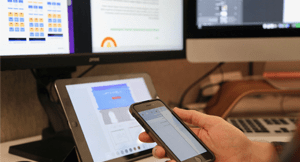Guest Post: Behind the Curtain with Predictive Analytics
BY R.J. Gravel, Ed.D.
In a perfect world, school business officials would all be clairvoyant and know exactly how revenues and expenses will shake out for years down the road. For now, predictive analytics are about as close as we’re going to get.
By analyzing historical data, identifying trends, and understanding the interactions between many different variables, we can make a reasonable projection of what our financial needs will be, barring any big surprises—and we may even be able to plan for those, too. Let’s explore the power of predictive analytics.
What are predictive analytics?
Predictive analytics are used to reliably project the expenditures and funding needs of a school district. The process uses a relatively simple combination of formulas, variable testing, local factors, and the SBO’s own experience to produce an informed forecast for multiple budget categories.Typically, we forecast for a period of no more than five years—any further and the forecast loses statistical significance.
How are predictive analytics applied?
For a practical demonstration, let’s apply a predictive model to salaries for certified teachers.Our district determined, based on 10 years of historical trends, that our certified staff salaries increased about 3.5% per year. To apply our predictive model for staff budgeting, we simply take the last budgeted figure and add 3.5%, then repeat for however many years we want forecast. This is the simplest application of forecasting, but it does not take into consideration any changes or course corrections.
Adjustments happen, and the key to successful forecasting is knowing how and when your models need to be tweaked. Back to our previous example of certified salaries—let’s suppose there is a year we anticipate a decline in enrollment and have several teachers retire whom we do not plan to replace. That year, I’ll enter a negative factor to reduce the FTE (which the system understands equals a certain salary amount). This in turn changes our salary projection.
How do these predictions get communicated?
Once we’ve forecasted our revenue and expenditures, the fund balance for each future year can be calculated. Projections are typically conservative, anticipating greater expenditures and less money coming in. It’s far better to err on the side of caution to ensure our students’ experience remains stable and uninterrupted.There are certain rules about the percentage of expenditures available in the bank—these are the red-flag numbers our school board needs to know when evaluating the financial condition of their local schools. The number-one projection many stakeholders are interested in seeing is jokingly referred to as the “fall off the cliff” chart: When is our school district’s financial condition projected to become concerning? Predictive analytics help us plan for this hypothetical future and anticipate needs without ever approaching the actual cliff.
After sharing critical data with the board, we can move on to sharing with the community. Our community stakeholders and taxpayers want to know about the overall financial condition of the school district, but they also want to understand how we’re spending money—what we’re giving to staff—raises, salaries, and other projections. Community members also want to know how we’re protecting ourselves from crises in the future—for example, a roof coming off a school not covered by insurance could result in a $15 million expenditure not budgeted for in a given year. That’s why we always include an outline of our capital expenditure projects.
It’s important to develop a clear, concise, and comprehensive document free of financial or legal jargon and accessible to any community member without the need for advanced training. We share explanations, stories, and charts to represent how our budget is balanced. We also produce a brief presentation to share a snapshot in time of the financial side of the district.
The communication of dense financial information is an art form. These documents are produced not with financial professionals in mind, but rather parents who are trying to understand their property tax increase, or who may be considering a move into the district. We want to tie the numbers back to our students, and we do that by being transparent about our supply budget, our academic experience budget, and our investment in teachers.
It's rewarding to be able to have a conversation with a concerned citizen about where their tax dollars are going and be able to instantly produce resources to explain. There’s no scramble to produce it just in time. The community knows our district has a plan based on data and rational thought, and our stakeholders know we are going to be fair and honest with them.
How are predictive analytics evolving?
Many people hear “predictive analytics” and immediately think about technology. The truth is, school business officials have a rich history of collaboration. We share each other’s Excel workbooks, talk through challenges together, and meet face-to-face or through digital mediums. These conversations sowed the seeds of predictive analytics long before the tech tools existed.That said, the tech sure does make things easier. With the comprehensive reporting tools now available to us, we can extract financial data on a daily basis and translate it to our analytical software. There is still a human component required in interpreting data, but we’re well beyond manual calculations. We can use automation and visualization to identify stability in our forecasted trends. For example, the +/- 200 student mobility rate in our district now consistently matches our projections by midyear. Do we need to maintain contracted services expenditures increasing at a rate of 3% each year, or can we target certain agreements and negotiate annual increases between 1–2% instead? Those are the levers we can pull and adjust as time goes on.
Predictive analytics allow us to make good use of historical data to produce a little bit of magic—a glimpse into the future. Every dollar we can unearth to invest in learning makes a difference.
WHAT'S NEXT FOR YOUR EDTECH? The right combo of tools & support retains staff and serves students better. We'd love to help. Visit skyward.com/get-started to learn more.

|
R.J. Gravel, Ed.D. Assistant Supt for Business Services/CSBO, Glenbrook 225, IL |




